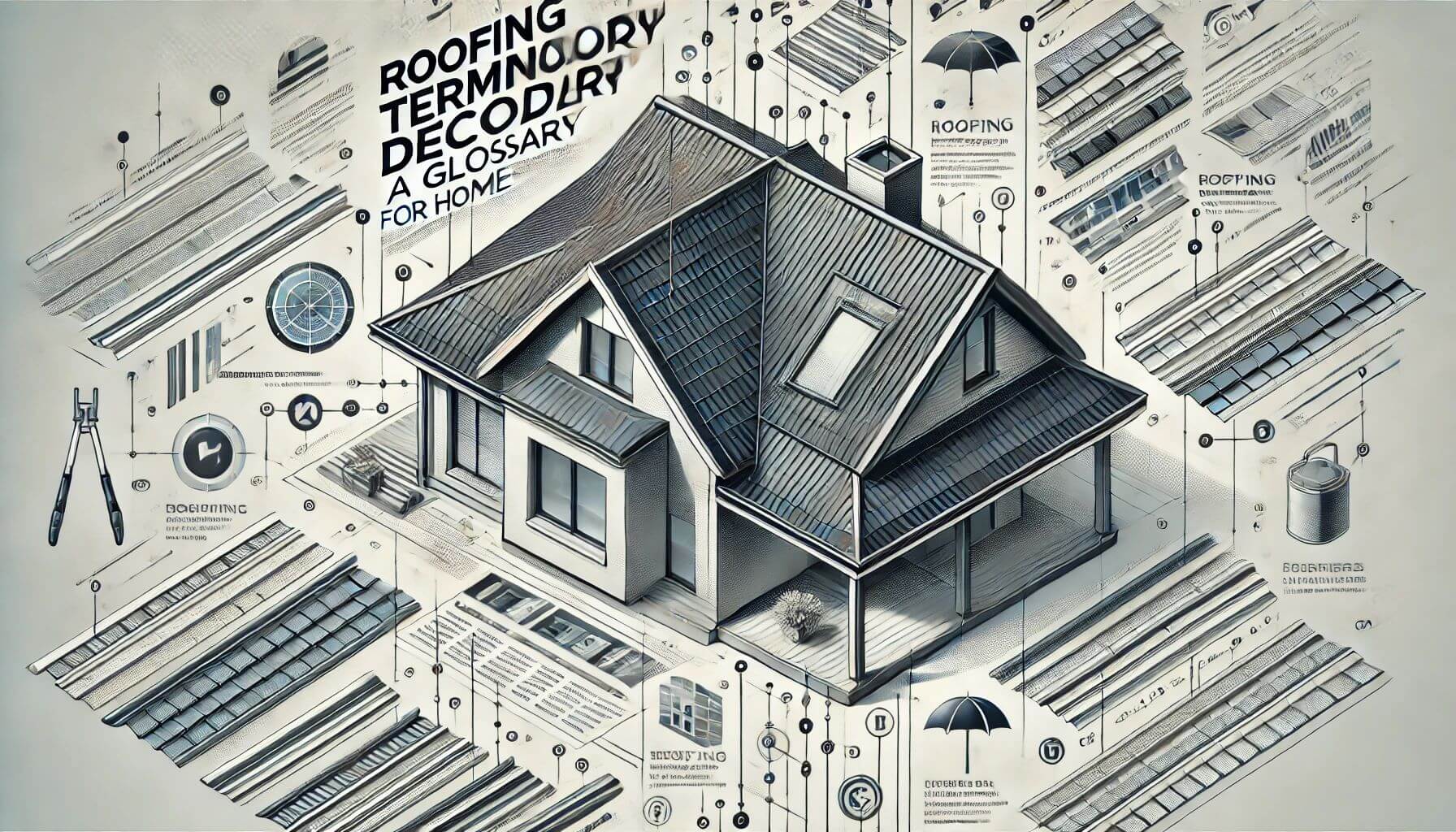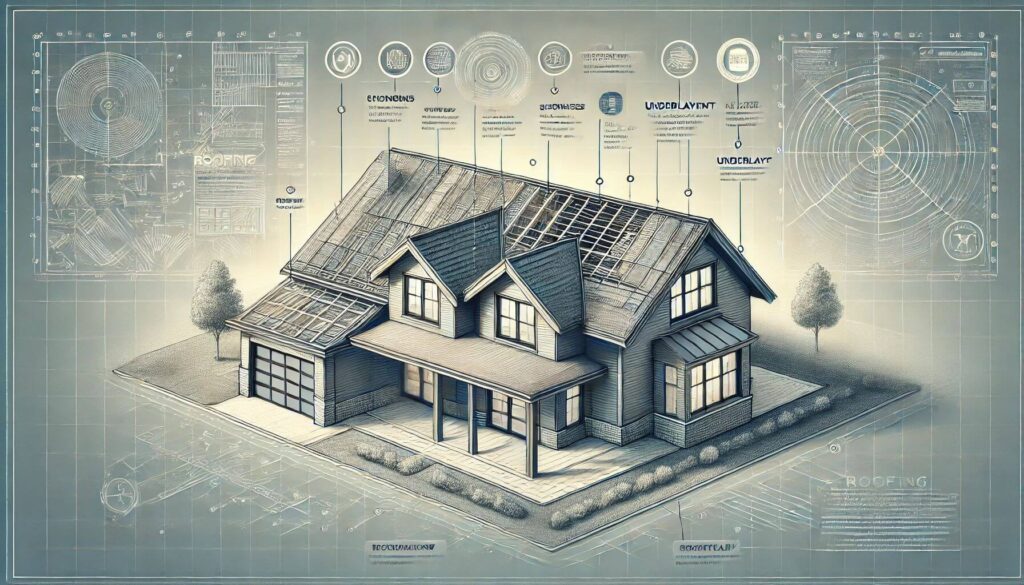
When it comes to maintaining or replacing your home’s roof, understanding the terminology used by roofing professionals can be overwhelming. As a homeowner, you might find yourself lost in a sea of unfamiliar terms and jargon. This comprehensive glossary aims to demystify common roofing terms, empowering you to make informed decisions about your home’s most important protective feature.
Basics of Roof Structure and Components
Let’s start with the fundamental elements that make up your roof’s structure. Understanding the anatomy of your roofing system is crucial for effective communication with roofing professionals and for making informed decisions about repairs or replacements.
- Deck: The structural foundation of your roof, typically made of plywood or oriented strand board (OSB).
- Underlayment: A protective layer installed directly on the roof deck, providing an additional barrier against water infiltration.
- Shingles: The outermost layer of the roof, available in various materials such as asphalt, wood, or metal.
- Flashing: Metal sheets used to waterproof areas where the roof meets walls, chimneys, or other roof sections.
- Ridge: The highest point of the roof where two sloping sides meet.
- Valley: The V-shaped area where two roof planes intersect, often requiring special attention to prevent leaks.
- Eaves: The lower edge of the roof that overhangs the walls, typically containing the gutters.
- Fascia: The horizontal board that runs along the lower edge of the roof, often supporting the gutters.
- Soffit: The underside of the roof overhang, often ventilated to allow attic airflow.
Roofing Materials: From Traditional to Innovative
The world of roofing materials is vast and ever-evolving. Understanding the different types of roofing materials can help you choose the best option for your home’s climate, style, and budget.
- Asphalt shingles: The most common roofing material in North America, known for their affordability and versatility.
- Metal roofing: Durable and energy-efficient, available in various styles and colors.
- Clay and concrete tiles: Long-lasting and aesthetically pleasing, often used in Mediterranean or Spanish-style homes.
- Slate: A premium, natural stone roofing material known for its beauty and longevity.
- Wood shakes and shingles: Offer a natural, rustic look but require more maintenance than other options.
- Synthetic slate and shake: Man-made alternatives that mimic the look of natural materials with added durability.
- Green roofing: Living roofs that support vegetation, offering environmental benefits and unique aesthetics.
- Solar tiles: Integrated roofing materials that generate electricity, combining functionality with sustainability.
Roofing techniques and installation terms
Understanding the techniques and terms used in roof installation can help you better appreciate the complexity of the roofing process and ensure quality workmanship.
- Tear-off: The process of removing old roofing materials before installing a new roof.
- Overlay: Installing new roofing materials over existing ones, sometimes used as a cost-saving measure.
- Nailing pattern: The specific arrangement of nails used to secure shingles, critical for proper installation and wind resistance.
- Starter strip: The first row of shingles installed at the roof’s edge to provide a clean, straight line and proper water shedding.
- Ice and water shield: A waterproof underlayment used in areas prone to ice dams or heavy rain.
- Drip edge: A metal strip installed along the roof’s edges to guide water away from the fascia and into the gutters.
- Ridge cap: Shingles specifically designed to cover and protect the ridge of the roof.
- Ventilation: The system of intake and exhaust vents that allow air to circulate through the attic space.
Roofing problems and repair terms
Familiarizing yourself with common roofing issues and repair terminology can help you identify potential problems early and communicate effectively with roofing professionals.
- Leak: An opening in the roof that allows water to penetrate the home’s interior.
- Ponding: The accumulation of standing water on flat or low-slope roofs, which can lead to deterioration.
- Blistering: Bubbles or raised areas in roofing materials, often caused by trapped moisture or poor ventilation.
- Buckling: Waviness or distortion in shingles, typically due to moisture or improper installation.
- Cupping: When shingle edges turn upward, often caused by age or excessive heat.
- Flashing failure: When the metal flashing around chimneys, vents, or other roof penetrations becomes damaged or loose.
- Ice dam: A ridge of ice that forms at the roof’s edge, preventing melting snow from draining properly.
- Chimney rebuilding: The process of repairing or reconstructing a damaged chimney, often necessary to prevent roof leaks.
Energy efficiency and sustainable roofing terms

As energy efficiency and sustainability become increasingly important, it’s crucial to understand the terminology associated with these aspects of roofing.
- Cool roof: A roofing system designed to reflect more sunlight and absorb less heat than a standard roof.
- Solar reflectance: The ability of a roofing material to reflect solar energy back into the atmosphere.
- Thermal emittance: The ability of a roof to radiate absorbed heat back into the atmosphere.
- R-value: A measure of thermal resistance, indicating how well a material insulates.
- Energy-efficient roofing: Roofing systems designed to reduce energy consumption and costs.
- Green roofing: Environmentally friendly roofing options, including living roofs and recycled materials.
- Sustainable roofing: Roofing practices and materials that minimize environmental impact and promote long-term ecological balance.
Roofing warranties and insurance terms
Understanding the terminology used in roofing warranties and insurance policies is crucial for protecting your investment and ensuring proper coverage.
- Manufacturer’s warranty: Covers defects in the roofing materials themselves.
- Workmanship warranty: Provided by the roofing contractor to cover installation errors.
- Prorated warranty: A warranty that decreases in coverage over time.
- Non-prorated warranty: A warranty that provides full coverage for the entire warranty period.
- Exclusions: Specific conditions or circumstances not covered by the warranty or insurance policy.
- Rider: An additional provision added to an insurance policy to expand or limit coverage.
- Depreciation: The decrease in value of your roof over time due to age and wear.
- Structural damage coverage: Insurance that covers damage to the roof caused by specific events like storms or fallen trees.
Empowering homeowners through knowledge
By familiarizing yourself with these roofing terms, you’re taking an important step towards becoming a more informed homeowner. This knowledge will serve you well when discussing roofing projects with contractors, understanding estimates and warranties, and making decisions about your home’s roofing needs.
Remember, while this glossary provides a solid foundation, roofing technology and terminology continue to evolve. Stay curious and don’t hesitate to ask professionals for clarification when needed. A reputable roofing contractor will always be willing to explain terms and processes in detail.
As you navigate the world of roofing, keep in mind that proper maintenance and timely repairs are key to extending your roof’s lifespan. Regular DIY roof inspections can help you catch potential issues early, saving you money and headaches in the long run.
Lastly, when it comes time for a roof replacement or major repair, always work with a qualified roofing contractor. They can guide you through the process, help you choose the best materials for your specific needs, and ensure that the job is done correctly.
Armed with this knowledge, you’re now better equipped to make informed decisions about one of your home’s most critical components. Your roof protects everything beneath it, and understanding its language is the first step in ensuring it continues to do its job effectively for years to come.



